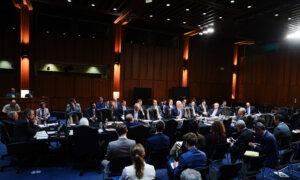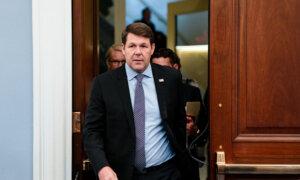The lower chamber’s ‘budget reconciliation’ resolution is in a single bill, whereas the Senate offers a two-bill package and more defense and border spending.
WASHINGTON—President Donald Trump announced on Feb. 19 that he supports the House of Representatives’ budget blueprint that would fund several of his policy initiatives, instead of a two-bill plan proffered by the Senate.
Ordinarily, to pass any legislation, at least 60 senators must vote to invoke “cloture” on a bill to limit debate and advance the bill to final passage. Without cloture, debate can continue indefinitely, and senators may “filibuster” to prevent the bill from being passed.
The Senate Republican Conference has only 53 members in the 100-member Senate, meaning that bills require the support of at least seven Democrats to pass—something that is unlikely to happen for conservative legislation.
Hence, for the past several months, “budget reconciliation” has been the focus. This process enables budgetary legislation—that is, concerning taxation, spending, and public borrowing—to be passed without minority party support.
The rules of the Senate limit debate on reconciliation-related bills. Cloture can be invoked with a simple majority. This would permit Republicans to pass partisan bills with their slim majorities in both houses of Congress.
Budget reconciliation first requires concurrent passage in both houses of a “budget resolution” that instructs committees to recommend spending increases or cuts, which are then used to draft any final bills. In this initial step, Republicans have faced disagreements between the House and Senate on both strategy and substance.
House Republicans want to pass only one bill that addresses all of their priorities—with consensus in the House being fragile. The Senate seeks to pass two bills, with the first addressing border security and immigration enforcement. This would give Congress more time to consider a second bill addressing the debt limit and tax cut expansion.
A reconciliation bill cannot increase the deficit after 10 years, which means that any permanent provisions must be offset by large spending reductions.
On Feb. 19, Trump voiced his preference for the House of Representatives’ plan for a single bill.
“We need both Chambers to pass the House Budget to ‘kickstart’ the Reconciliation process, and move all of our priorities to the concept of, ‘ONE BIG BEAUTIFUL BILL.’”
He referred to Senate Budget Committee Chairman Lindsey Graham (R-S.C.), who has sponsored the Senate’s approach.
“Nothing would please me more than one big, beautiful bill. … That is my preference,“ Graham said at a news conference on Feb. 11. ”Now, what guides my thinking is the problem we have now: We’re running out of money.
“To my friends in the House, we’re moving because we have to. … We’re not building a wall, folks, we’re hitting a wall. [The Trump Administration needs] the money, and they need it now.”
The House’s budget resolution seeks to allocate $4.5 trillion for taxation-related matters. This would mean extending some rate reductions of the Tax Cuts and Jobs Act of 2017 and allowing for a $4 trillion increase in the federal government’s sovereign debt limit.
However, it would also allocate less money for defense spending and border security than the Senate’s plan.
At a news conference on Feb. 19, Senate Majority Leader John Thune (R-S.D.) said, “If the House can produce one big, beautiful bill, we’re prepared to work with them to get that across the finish line.”
But he added that the Senate would proceed with its own budget resolution and two-bill approach. “We believe that the president also likes optionality,” Thune said.
Original News Source Link – Epoch Times
Running For Office? Conservative Campaign Consulting – Election Day Strategies!


